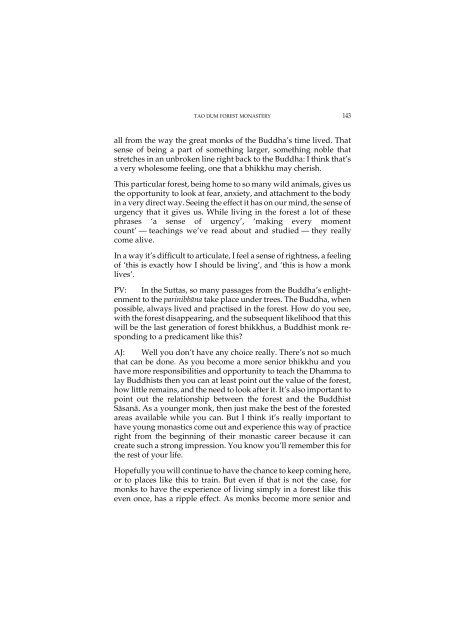Forest Path - Amaravati Buddhist Monastery
Forest Path - Amaravati Buddhist Monastery
Forest Path - Amaravati Buddhist Monastery
You also want an ePaper? Increase the reach of your titles
YUMPU automatically turns print PDFs into web optimized ePapers that Google loves.
tao dum forest monastery 143<br />
all from the way the great monks of the Buddha’s time lived. That<br />
sense of being a part of something larger, something noble that<br />
stretches in an unbroken line right back to the Buddha: I think that’s<br />
a very wholesome feeling, one that a bhikkhu may cherish.<br />
This particular forest, being home to so many wild animals, gives us<br />
the opportunity to look at fear, anxiety, and attachment to the body<br />
in a very direct way. Seeing the effect it has on our mind, the sense of<br />
urgency that it gives us. While living in the forest a lot of these<br />
phrases ‘a sense of urgency’, ‘making every moment<br />
count’ — teachings we’ve read about and studied — they really<br />
come alive.<br />
In a way it’s difficult to articulate, I feel a sense of rightness, a feeling<br />
of ‘this is exactly how I should be living’, and ‘this is how a monk<br />
lives’.<br />
PV: In the Suttas, so many passages from the Buddha’s enlightenment<br />
to the parinibbàna take place under trees. The Buddha, when<br />
possible, always lived and practised in the forest. How do you see,<br />
with the forest disappearing, and the subsequent likelihood that this<br />
will be the last generation of forest bhikkhus, a <strong>Buddhist</strong> monk responding<br />
to a predicament like this?<br />
AJ: Well you don’t have any choice really. There’s not so much<br />
that can be done. As you become a more senior bhikkhu and you<br />
have more responsibilities and opportunity to teach the Dhamma to<br />
lay <strong>Buddhist</strong>s then you can at least point out the value of the forest,<br />
how little remains, and the need to look after it. It’s also important to<br />
point out the relationship between the forest and the <strong>Buddhist</strong><br />
Sàsanà. As a younger monk, then just make the best of the forested<br />
areas available while you can. But I think it’s really important to<br />
have young monastics come out and experience this way of practice<br />
right from the beginning of their monastic career because it can<br />
create such a strong impression. You know you’ll remember this for<br />
the rest of your life.<br />
Hopefully you will continue to have the chance to keep coming here,<br />
or to places like this to train. But even if that is not the case, for<br />
monks to have the experience of living simply in a forest like this<br />
even once, has a ripple effect. As monks become more senior and

















